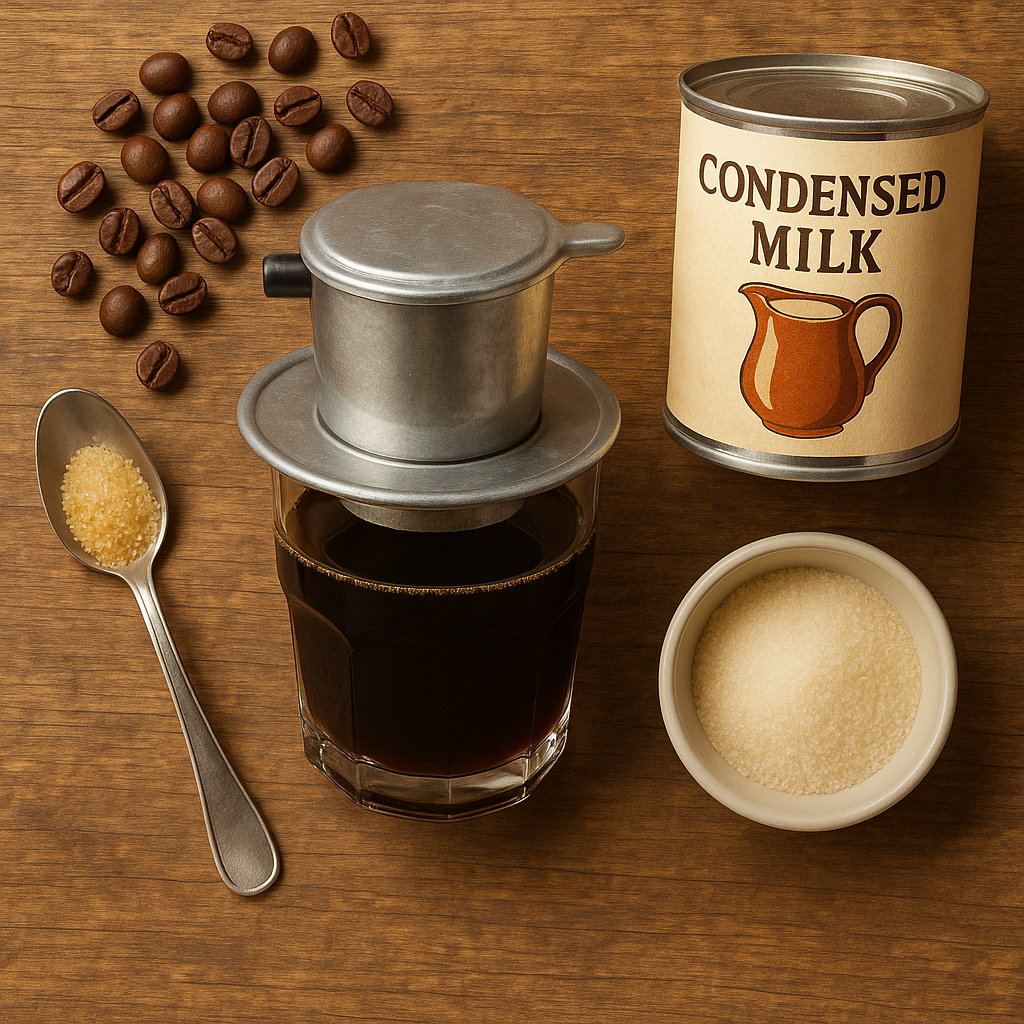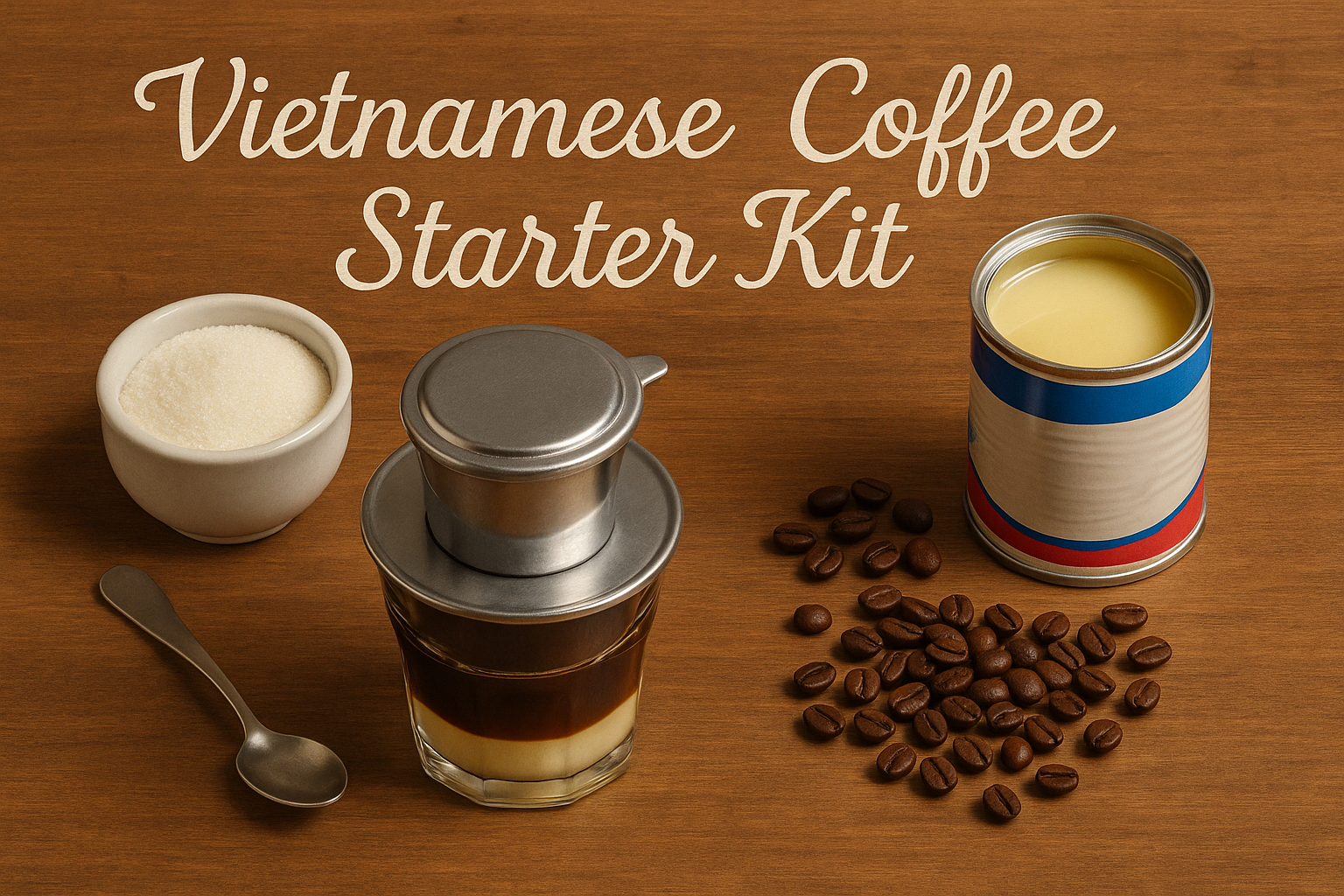Introduction: Your Gateway to Vietnamese Coffee Culture
My name is Marco, and my first encounter with Vietnamese coffee happened in a narrow alley in Ho Chi Minh City fifteen years ago. I watched an elderly woman pour dark, concentrated coffee through a small metal filter into a glass already filled with condensed milk and ice. The ritual was mesmerizing—patient, deliberate, and utterly different from any coffee preparation I'd ever witnessed. That first sip of cà phê sữa đá changed my understanding of what coffee could be.
Vietnamese coffee culture represents one of the world's most unique and approachable coffee traditions. Unlike expensive espresso machines or complex brewing equipment, Vietnamese coffee requires minimal investment while delivering maximum flavor and cultural authenticity. Today, I'll guide you through everything you need to start your own Vietnamese coffee journey at home.
Why Start with Vietnamese Coffee?
- Low Barrier to Entry: Minimal equipment investment required
- Unique Flavor Profile: Bold, strong coffee with distinctive taste
- Cultural Experience: Connect with centuries of Vietnamese tradition
- Versatile: Hot, iced, with milk, or black variations
- Social Aspect: Perfect for slow, contemplative coffee moments
Understanding Vietnamese Coffee Culture
Before diving into equipment and techniques, it's essential to understand the cultural context that shapes Vietnamese coffee. This isn't just about brewing methods—it's about embracing a lifestyle and philosophy around coffee consumption.
Key Cultural Elements
- Patience as Virtue: Vietnamese coffee brewing is deliberately slow, encouraging contemplation
- Social Gathering: Coffee shops serve as community centers for conversation and connection
- French Colonial Influence: Coffee culture blends Vietnamese and French traditions
- Daily Ritual: Coffee consumption is integrated into daily life, not rushed
- Seasonal Adaptation: Hot coffee in cooler months, iced versions for tropical climate
The Philosophy of Slow Coffee
Vietnamese coffee culture emphasizes the journey over the destination. The 5-7 minute brewing process isn't seen as inefficient—it's an opportunity to slow down, reflect, and engage with friends or family. This mindset shift is perhaps the most important element of your starter kit.
Cultural Etiquette
In Vietnam, rushing your coffee is considered impolite. The slow drip is part of the experience, allowing time for conversation and contemplation. Embrace this patience—it's as important as any equipment you'll purchase.
Essential Equipment: Building Your Vietnamese Coffee Arsenal
The beauty of Vietnamese coffee lies in its simplicity. Unlike espresso setups that can cost thousands, a complete Vietnamese coffee kit requires minimal investment while delivering authentic results.
The Vietnamese Phin Filter
1Traditional Phin Filter (Essential)
What it is: A small metal filter consisting of a brewing chamber, perforated plate, and lid.
Sizes available: Single serve (8-12 oz) or sharing size (16-20 oz)
Materials: Stainless steel (recommended) or aluminum
Price range: $8-25 for quality filters
Why it matters: The phin's unique design creates the slow extraction that defines Vietnamese coffee's character.
2Heat-Resistant Glasses or Cups
Traditional choice: Clear glass cups to showcase the brewing process
Practical alternatives: Heavy ceramic mugs or heat-resistant glass mugs
Capacity: 6-8 oz for proper coffee-to-milk ratios
Price range: $10-30 for a set of 4
3Sweetened Condensed Milk
Authentic brands: Longevity Brand, Eagle Brand, or Vietnamese imports
Alternatives: Coconut condensed milk for dairy-free options
Storage: Refrigerate after opening, lasts 2-3 weeks
Usage: 1-3 tablespoons per cup depending on sweetness preference
4Coffee Spoon or Small Stirrer
Purpose: For stirring condensed milk and adjusting the phin filter
Style: Long-handled spoons work best for tall glasses
Material: Stainless steel preferred for durability
Choosing Authentic Vietnamese Coffee
The coffee itself is arguably the most crucial component of your starter kit. Vietnamese coffee has distinct characteristics that differ significantly from typical Western coffee preferences.
Traditional Vietnamese Coffee Characteristics
Authentic Vietnamese Coffee Profile
- Bean Type: Primarily Robusta (60-80%) blended with Arabica
- Roast Level: Dark to French roast, often with added butter or oils
- Grind Size: Medium to medium-coarse for optimal phin extraction
- Flavor Notes: Bold, earthy, chocolatey, with low acidity
- Caffeine Content: Higher than typical Arabica due to Robusta content
Recommended Coffee Brands
1Trung Nguyen (Premium Choice)
Varieties: Creative 1-5 blends, with Creative 3 being most popular
Characteristics: Traditional Vietnamese taste with consistent quality
Availability: Vietnamese markets, online retailers
Price: $12-18 per 500g bag
2Café Du Monde (Accessible Option)
Style: Coffee and chicory blend in French tradition
Taste: Smooth, slightly sweet, less intense than pure Vietnamese
Availability: Most US grocery stores
Price: $6-10 per can
3Nguyen Coffee Supply (Artisan Choice)
Focus: Ethically sourced, single-origin Vietnamese coffees
Education: Excellent for learning about Vietnamese coffee varieties
Quality: Premium beans with detailed origin information
Price: $15-25 per bag
Essential Vietnamese Coffee Recipes
Your starter kit should include knowledge of the three fundamental Vietnamese coffee preparations. Master these before exploring variations.
Cà Phê Sữa Nóng (Hot Vietnamese Coffee with Milk)
Traditional Hot Coffee Recipe
- Coffee: 2-3 tablespoons Vietnamese coffee, medium-coarse grind
- Condensed Milk: 1-2 tablespoons in bottom of cup
- Water: 6-8 oz hot water (200°F/93°C)
- Brew Time: 5-7 minutes
- Serving: Stir well before drinking
Cà Phê Sữa Đá (Iced Vietnamese Coffee)
Authentic Iced Coffee Recipe
- Preparation: Follow hot coffee recipe above
- Ice: Fill a second glass with ice cubes
- Technique: Pour hot coffee over ice immediately after brewing
- Result: Sweet, strong, refreshing iced coffee
- Serving: Drink quickly to enjoy optimal temperature contrast
Cà Phê Đen (Black Vietnamese Coffee)
Pure Black Coffee Recipe
- Coffee: 2-3 tablespoons Vietnamese coffee
- Water: 6-8 oz hot water
- No additions: Served without milk or sugar
- Character: Strong, bold, earthy flavor
- Cultural note: Often consumed by older generations

Mastering the Phin Brewing Technique
The phin filter may look simple, but proper technique is essential for authentic results. Here's the step-by-step process perfected through generations of Vietnamese coffee culture.
Step-by-Step Brewing Process
1Prepare Your Setup
Place 1-2 tablespoons condensed milk in your cup. Set the phin filter on top, ensuring stable positioning. Have your hot water ready at 200°F (93°C).
2Add Coffee and Level
Add 2-3 tablespoons of coffee to the phin chamber. Gently shake to level the grounds, creating an even surface for water contact.
3Insert Filter Plate
Place the perforated plate on top of coffee grounds. Press down gently—it should have slight resistance but not be overly tight.
4Bloom the Coffee
Pour a small amount of hot water (about 2 tablespoons) over the grounds. Wait 30 seconds for the coffee to "bloom" and release CO2.
5Full Water Addition
Slowly fill the chamber with remaining water. Place the lid on top to retain heat. The coffee should drip steadily—not too fast, not too slow.
6Wait Patiently
Allow 5-7 minutes for complete extraction. Resist the urge to rush—this slow process creates Vietnamese coffee's distinctive character.
7Stir and Enjoy
Remove the phin filter and stir the coffee and condensed milk thoroughly. Taste and adjust sweetness if needed.
Complete Starter Kit Recommendations
Based on fifteen years of experience with Vietnamese coffee, I've curated three starter kit options to match different budgets and commitment levels.
Budget-Friendly Starter Kit ($25-35)
Essential Budget Kit
- Phin Filter: Basic stainless steel single-serve ($8-12)
- Coffee: Café Du Monde coffee and chicory ($6-8)
- Condensed Milk: Eagle Brand sweetened condensed milk ($3-4)
- Glasses: Heat-resistant glass mugs ($8-12)
- Total Investment: $25-36
- Best for: First-time Vietnamese coffee explorers
Premium Starter Kit ($50-75)
Premium Experience Kit
- Phin Filter: High-quality stainless steel with fine perforations ($15-25)
- Coffee: Trung Nguyen Creative 3 blend ($12-18)
- Condensed Milk: Premium Longevity Brand ($4-6)
- Glassware: Traditional Vietnamese coffee glasses set ($15-20)
- Accessories: Long spoon, small milk pot ($8-12)
- Total Investment: $54-81
- Best for: Serious coffee enthusiasts wanting authentic experience
Complete Enthusiast Kit ($80-120)
Complete Vietnamese Coffee Setup
- Multiple Phin Filters: Single and sharing sizes ($25-35)
- Variety Coffee Pack: 3-4 different Vietnamese coffee types ($25-40)
- Premium Condensed Milk: Multiple types including coconut ($8-12)
- Complete Glassware: Hot and iced coffee glasses ($20-25)
- Accessories: Spoons, thermometer, storage containers ($10-15)
- Total Investment: $88-127
- Best for: Dedicated Vietnamese coffee lovers and entertainers
Where to Shop: Finding Authentic Vietnamese Coffee Supplies
Sourcing authentic Vietnamese coffee equipment and ingredients can be challenging depending on your location. Here's your comprehensive shopping guide.
Online Retailers
Recommended Online Sources
- Amazon: Wide selection of phin filters and Vietnamese coffee
- Nguyen Coffee Supply: Premium Vietnamese coffee specialist
- Vietnamese grocery stores online: Most authentic ingredients
- Williams Sonoma: High-quality phin filters and accessories
- Sweet Maria's: Educational resources and quality equipment
Local Shopping Options
Local Shopping Tips
- Asian Markets: Best source for authentic Vietnamese coffee and condensed milk
- Vietnamese Restaurants: Many sell retail coffee and equipment
- Specialty Coffee Shops: Increasingly carrying Vietnamese coffee supplies
- Kitchen Supply Stores: Often stock phin filters in major cities
Common Beginner Mistakes and Solutions
Every Vietnamese coffee beginner encounters similar challenges. Here are the most common issues and their solutions:
Brewing Problems
Coffee Drips Too Fast
Causes: Grind too coarse, filter plate too loose, or insufficient coffee
Solutions: Use finer grind, press filter plate more firmly, increase coffee amount
Coffee Drips Too Slow or Stops
Causes: Grind too fine, filter plate too tight, or clogged filter
Solutions: Use coarser grind, adjust filter plate pressure, clean filter thoroughly
Weak or Watery Coffee
Causes: Insufficient coffee, water too cool, or brewing time too short
Solutions: Increase coffee amount, use hotter water (200°F), allow full brewing time
Bitter or Over-Extracted
Causes: Too much coffee, grind too fine, or over-brewing
Solutions: Reduce coffee amount, use coarser grind, monitor drip rate
Advanced Tips for Vietnamese Coffee Mastery
Once you've mastered the basics, these advanced techniques will elevate your Vietnamese coffee experience to authentic levels.
Pro Techniques
Professional Secrets
- Pre-warm Equipment: Rinse phin and cup with hot water before brewing
- Coffee Bloom: Always allow 30-second bloom for optimal extraction
- Water Quality: Use filtered water for cleaner taste
- Consistent Technique: Develop muscle memory for filter pressure
- Temperature Monitoring: Keep water at 200°F throughout brewing
Seasonal Variations
Seasonal Adaptations
- Summer: Double-strength coffee over extra ice
- Winter: Serve hot with additional condensed milk
- Spring: Add mint leaves for refreshing variation
- Holiday: Cinnamon or cardamom spice additions
Conclusion: Beginning Your Vietnamese Coffee Journey
After fifteen years of exploring Vietnamese coffee culture, I can say with confidence that starting this journey is one of the most rewarding investments any coffee lover can make. The equipment is minimal, the techniques are straightforward, and the cultural richness is immense. Most importantly, Vietnamese coffee teaches us the value of patience and mindfulness in our daily routines.
Your starter kit is just the beginning. As you develop your palate and technique, you'll discover the subtle variations that make each cup unique. You'll learn to appreciate the slow drip not as inefficiency, but as meditation. You'll understand why Vietnamese coffee culture has thrived for over a century with minimal changes to its fundamental approach.
Your Next Steps
Start with the budget-friendly kit to explore whether Vietnamese coffee appeals to you. If you find yourself drawn to the culture and flavors, gradually upgrade your equipment and expand your coffee variety. Remember that authenticity comes from understanding and respecting the tradition, not from expensive equipment.
Don't be discouraged if your first attempts don't match café quality. Vietnamese coffee mastery comes through practice, patience, and genuine appreciation for the process. Each cup teaches you something new about extraction, timing, and balance.
Most importantly, share the experience. Vietnamese coffee is inherently social—invite friends to join your brewing sessions, teach others what you learn, and create the community connections that make this tradition so special. The slow pace of Vietnamese coffee creates natural opportunities for conversation and relationship building.
Welcome to the wonderful world of Vietnamese coffee. May your phin filter bring you countless moments of calm, connection, and exceptional coffee.
Chúc bạn thưởng thức cà phê ngon! (Enjoy your delicious coffee!)
